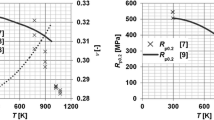Abstract
Work hardening induced by manufacturing processes has important consequences for the resistance to the stress corrosion cracking (SCC) of low-carbon stainless steel in high-temperature water conditions. It is of great importance to understand the mechanisms and the factors promoting environmentally assisted cracking in such environments. In this study, the effect of work hardening on 316L austenitic stainless steel was studied using a small-punch SCC test facility applied to miniaturized specimens. Tests were performed in a boiling water reactor (BWR) environment with trapezoidal loading. After the tests, the fracture faces and the surfaces of the samples were examined with a scanning electron microscope (SEM). Focused ion beam (FIB) etching was used to prepare samples for the SEM observations. Identification of the oxide was done using a Raman spectroscope and comparison of the data to reference spectra. The results showed the unfavorable effect of cold rolling against crack initiation. The oxide composition is affected by work hardening. Hence, the ferrous oxide formation is promoted by Fe diffusion caused by the dislocation density increase associated with an active strain during the test.












Similar content being viewed by others
References
T.M. Angeliu, P.L. Andresen, E. Hall, J.A. Sutliff, S. Sitzman, and R.M. Horn: 9th Int. Symp. on Environmental Degradation of Materials in Nuclear Power Systems-Water Reactor, S. Bruemmer, P. Ford, and G. Was, eds., Newport Beach, CA, TMS, Warrendale, PA, 1999, pp. 311–18
Y. Kanazawa and M. Tsubota: Corrosion 94, NACE, Baltimore, MD, 1994, paper 237
J. Kuniya, I. Masaoka, R. Sasaki: Corrosion, 1988, vol. 44(1), pp. 21–28
M.P. Manahan, A.S. Argon, O.K. Harling: J. Nucl. Mater., 1981, vols. 103–104, pp. 1545–50
T. Misawa, H. Sugawara, R. Miura, Y. Hamaguchi: J. Nucl. Mater., 1985, vols. 133–134, pp. 313–16
J. Foulds, R. Viswanathan: J. Eng. Mater. Technol., 1994, vol. 116, pp. 457–64
G.E. Lucas, A. Osaka, M. Kiritani: J. Nucl. Mater., 1986, vols. 141–143, pp. 532–35
X. Mao, M. Saito, H. Takahashi: Scripta Metall. Mater., 1995, vol. 21, pp. 2481–85
S.-I. Komazaki: J. Testing Eval., 2000, vol. 28, pp. 246–56
N. Saito, H. Sakamoto, K. Sugimoto: Corrosion, 1998, vol. 54, pp. 700–12
A. Kai: Ph.D. Thesis, Tohoku University, Sendai, Japan, 2005
Acknowledgment
This work has been supported by the PEACE project.
Author information
Authors and Affiliations
Corresponding author
Additional information
Manuscript submitted January 26, 2007.
Rights and permissions
About this article
Cite this article
Isselin, J., Kai, A., Sakaguchi, K. et al. Assessment of the Effects of Cold Work on Crack Initiation in a Light Water Environment Using the Small-Punch Test. Metall Mater Trans A 39, 1099–1108 (2008). https://doi.org/10.1007/s11661-008-9492-7
Published:
Issue Date:
DOI: https://doi.org/10.1007/s11661-008-9492-7



